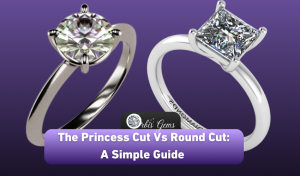Are you torn between choosing a moissanite vs diamond for that special piece of jewelry? In the ever-evolving world of gemstones, the ‘moissanite vs diamond’ debate has captured the attention of both jewelers and consumers alike.
This blog post delves into the heart of this sparkling showdown, offering essential insights and comparisons to help you make an informed decision. We’ll explore the unique characteristics of both stones, from their brilliance and durability to their environmental impact and cost-effectiveness.
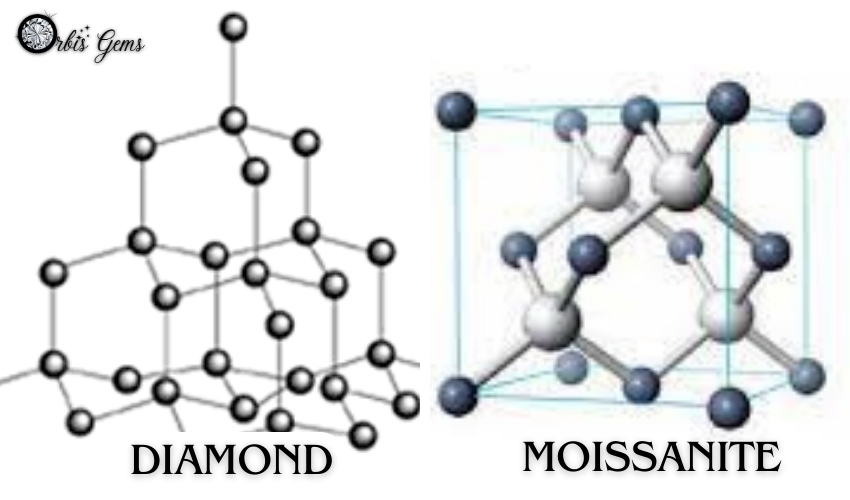
Definitions Of A Moissanite vs Diamond
What Is Moissanite?
Moissanite is a special kind of gemstone. It’s made of something called silicon carbide. A French scientist named Henri Moissan found it in 1893. He discovered it in a place where a meteor had hit the Earth, leading to the formation of natural moissanite, which is very rare. Because it’s so rare, the moissanite we use in jewelry, such as moissanite engagement rings, is usually made in labs. This artificial form is known as silicon carbide moissanite. [1]
People often think of moissanite as similar to diamonds, a popular choice for diamond engagement rings. It’s designed to resemble diamonds, a diamond simulant. But it’s quite different. Diamonds are made from carbon, while moissanite, on the other hand, is made from silicon carbide. [2][3]
What Is A Diamond?
Diamonds are a kind of carbon. They have a special shape called diamond cubic. This shape makes them very hard and good at moving heat. Diamonds, often sought after for diamond engagement rings, are also valued as gems because they are bright, hard, and rare, formed deep in the Earth over billions of years, under high heat and pressure.
Diamonds look diffe ent from graphite, another kind of carbon. Graphite is soft because its atoms are in layers. Diamonds uniformly have their atoms, making them hard. Diamonds come in different colors, including the rare and most wanted colorless diamond.
Diamonds are linked to April birthdays and represent lasting love. They are often used in engagement ring stones and for special anniversaries.[4][5][6]
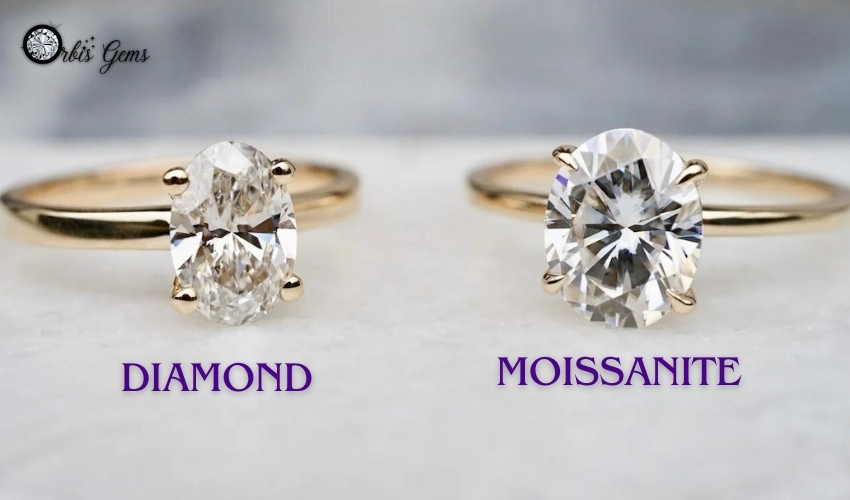
Moissanite vs Diamond: Which is More Beautiful?
If you look closely with just your eyes, compare a moissanite stone and a diamond of the same size next to each other. You will see they shine differently. Diamonds, often used in diamond engagement rings, have a special sparkle. They shine, show colors, and twinkle in a special way. Moissanite stones, on the other hand, show more colors and look like a rainbow when moved. This rainbow effect is stronger in sunlight.
The bigger the moissanite stone, the more color you see. It then looks less like a diamond. Some people choose smaller moissanite stones for their moissanite engagement rings because of this. Still, usually, only a jeweler or someone who knows a lot about jewelry can tell them apart. [7]
Brilliance and Fire Of Moissanite vs Diamond
Brilliance and Fire of A Moissanite
Moissanite is a special gemstone known for its shine and color. Its “brilliance” means it reflects light very well. Moissanite shines more than natural diamonds because it has a higher “refractive index.” This index measures how much light a gemstone can bend. Moissanite’s index is 2.65, higher than diamond’s 2.42.
Another cool feature is its “fire.” This is about the rainbow colors you see in the gem. Moissanite’s fire is stronger than that of natural diamonds. It scores 0.104, while diamonds score 0.044. This means moissanite gemstones show more rainbow colors. [8][9]
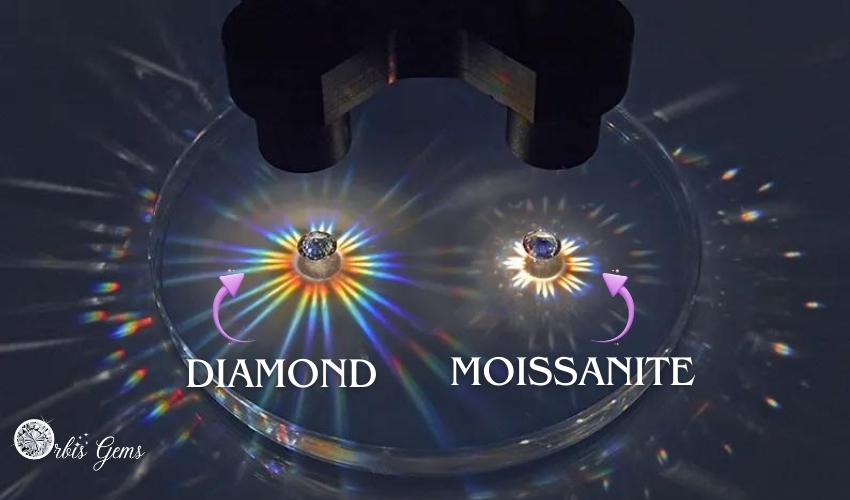
Brilliance and Fire of A Diamond
Diamonds are renowned for their sparkle, a result of two key qualities: brilliance and fire. Brilliance refers to the reflection of white light, making diamonds appear bright and shiny. This effect is enhanced by the diamond’s cut, with ideal proportions including a depth between 59% and 63%, a table size from 54% to 57%, crown angles ranging from 31.5% to 36.5%, and pavilion angles between 40% and 42%. Good polish and symmetry also contribute to a diamond’s brilliance.
Fire, on the other hand, pertains to the colorful rainbow seen within a diamond when it moves. This is caused by light fracturing into multiple colors inside the diamond. The clarity of the diamond amplifies this effect, with clearer diamonds displaying more fire.
Both brilliance and fire are indicators of a diamond’s quality, reflecting the skill involved in its cutting. The interplay of these attributes, along with the type of light, gives each diamond its unique sparkle, making those with a harmonious balance of good brilliance and fire particularly special and valuable. [10][11]
Color Of Moissanite vs Diamond
Color of A Moissanite
Moissanite engagement rings often feature stones that display a noticeable rainbow-like effect, particularly under sunlight or intense lighting. While advancements in technology have led to the creation of high-quality colorless moissanite, some moissanite gems can still project slight yellow or greenish hues in certain lights, especially in larger stones.
Historically, moissanite had a yellowish or greenish tint, but the latest forms like Forever One are more colorless compared to earlier forms like Classic Moissanite.[12][13]
Color of A Diamond
Diamonds, particularly those used in diamond engagement rings, are traditionally graded on a color scale that ranges from D (colorless) to Z (light yellow or brown). Diamonds can also come in fancy colors like blue or pink, but these are rare.
The most prized diamonds, often chosen for engagement rings, are those that are near-colorless, showing little to no color. Unlike moissanite, natural diamonds do not typically show a rainbow-like effect. [14]
Clarity Of Moissanite vs Diamond
Clarity of A Moissanite
The clarity of moissanite, a popular choice for engagement rings, tells us about its imperfections. These are called inclusions and happen when things like crystals or gas bubbles get trapped in the moissanite gemstone while it forms.
Typically, these inclusions are not visible to the naked eye, requiring magnification for detection. The best clarity for moissanite, often sought for unique engagement rings, is between VVS1 and VS2, similar to the VS grade on the diamond scale.
Types of Inclusions in Moissanite
- Needles: These are long and thin, like a needle. They’re white or see-through and need magnification to be seen.
- Mineral Crystals: These are crystals inside the stone. They can be light or dark.
- Clouds: These make the stone look hazy. They are actually groups of tiny crystals.
- Feathers: These are very small cracks inside the stone.
- Knots: You can see these on the stone’s surface. They are white or clear.
- Chips: These are small, shallow cuts on the surface of the stone.
Moissanite’s clarity can range from flawless (FL) to I3, which has more visible inclusions. But up to a certain level, these inclusions are only seen with magnification.[15][16]
Clarity of A Diamond
Diamond clarity refers to the absence of inclusions (internal characteristics) and blemishes (external imperfections). These occur naturally as diamonds form under high pressure and temperature conditions deep within the Earth. Most inclusions and blemishes are microscopic and require magnification to be seen.
Types of Inclusions and Blemishes in Diamonds
- Crystal Inclusions: Other minerals trapped inside the diamond.
- Feathers: Small cracks in the diamond, potentially weakening it.
- Clouds: Clusters of tiny inclusions, making parts of the diamond appear hazy.
- Pinpoints: Very small dots, often invisible to the naked eye.
- Scratches and Chips: Surface flaws, with chips typically found on edges.
The Gemological Institute of America (GIA) has established a clarity grading scale, ranging from Flawless to Included:
- Flawless (FL): No inclusions or blemishes visible under 10x magnification.
- Internally Flawless (IF): No inclusions, but might have minor blemishes.
- Very, Very Slightly Included (VVS1, VVS2): Inclusions difficult to see under 10x magnification.
- Very Slightly Included (VS1, VS2): Minor inclusions seen with effort under 10x magnification.
- Slightly Included (SI1, SI2): Inclusions noticeable under 10x magnification.
- Included (I1, I2, I3): Inclusions obvious under 10x magnification, affecting transparency and brilliance.
The differences between these grades, especially in the higher categories, are often subtle but significant in terms of quality and cost. The higher the clarity, the more rare and valuable the diamond tends to be.[17][18][19]

Is Diamond More Durable Than Moissanite?
Hardness Of Moissanite vs Diamond
Hardness of A Moissanite
On the Mohs scale, which measures how hard minerals are, moissanite scores between 9.25 and 9.5. This scale goes from 1 to 10, with 10 being the hardest. Diamonds, the hardest, score a 10. But moissanite is very close to that. This means it doesn’t scratch easily. That’s important for jewelry that you wear every day, like rings.[20]
Hardness of A Diamond
Diamond is the hardest material we find naturally. It ranks as a 10 on the Mohs scale, which measures how hard minerals are.[21][22] It’s key to remember that being hard doesn’t mean it’s tough. Diamonds are super hard, but they’re not very tough. This means they can break more easily than you might think.[23]
Compared to Corundum, which makes rubies and sapphires, diamonds are 4 times harder.[24] On a scale where hardness values are straight-lined, diamonds would score around 42.[25] But despite this, diamonds can still chip or break if hit hard enough.[26]
The hardness of a diamond changes based on the direction you measure it. For example, if you measure a diamond’s hardness in a certain direction using a tiny diamond tip, it can reach a hardness of 167 GPa.[27]So, diamonds are incredibly hard, but they are not indestructible and their hardness can vary.
Toughness Of Moissanite vs Diamond
Toughness of A Moissanite
Moissanite is known for its impressive toughness. This means it resists breaking or chipping well. Compared to a diamond, it’s almost as hard, scoring 9.25 on the Mohs hardness scale. This scale measures how easily a mineral can be scratched. Diamonds, the hardest mineral, score 10. Moissanite’s toughness makes it great for everyday jewelry like rings.
It keeps its beauty over time, even with regular wear. Its ability to resist damage adds to its popularity as a gemstone, especially as a diamond alternative. Moissanite is a strong choice for those who want a durable and lasting gemstone. [28][29]
Toughness of A Diamond
Diamond is the hardest thing found in nature. But its toughness, how well it can take a hit without breaking or getting damaged, is just okay. A diamond’s toughness is measured at 2.0 MPa⋅m 1/2. This is better than gems like light blue aquamarine, but not as good as many materials used in engineering.
We don’t know exactly how strong a diamond is when pulled, but it can handle a lot of pressure – up to 60 GPa. This strength might even reach 90–100 GPa in tiny wires or needles. When cutting diamonds, it’s important to consider how the hardness changes in different directions.[30]

Budget and Size for Moissanite vs. Diamond
When comparing the price and size of moissanite and diamonds in South African Rands (ZAR), moissanite remains a more budget-friendly option with a similar aesthetic appeal. Here’s a breakdown of their budget and size differences in ZAR:
Price
- Moissanite: The cost of moissanite is considerably lower than diamonds. For a one-carat moissanite, the price ranges from ZAR 9,000 to ZAR 12,000. This affordability allows for choosing larger or higher-quality stones within the same budget as compared to diamonds.
- Diamonds: Diamonds are generally pricier than moissanite. The starting price for a one-carat diamond is around ZAR 67,500, escalating significantly for higher quality factors. A two-carat diamond can cost upwards of ZAR 180,000.
Size
- Moissanite’s affordability means greater flexibility in terms of size within a given budget. This allows buyers to select larger stones for the same price as smaller diamonds.
- For diamonds, the size heavily influences the price. As the carat weight increases, so does the cost, often substantially. This makes larger diamonds an expensive choice.[31]
Should You Choose a Moissanite Engagement Ring Over a Diamond?
When choosing an engagement ring, you might wonder whether to pick moissanite or a diamond. Here’s a simple guide to help you decide, covering price, durability, sparkle, and ethics.
Price Matters: Moissanite is way cheaper than diamonds.[32] A moissanite gem costs about one-tenth of a similar diamond.
How Tough Are They? Diamonds are super hard, the hardest mineral we know. Moissanite is also tough, almost as much as diamonds.
Sparkle and Shine: Moissanite sparkles more than diamonds, giving off a rainbow effect.[33] Diamonds have a classic white light sparkle.[33]
Thinking About Ethics: Moissanite is made in labs, so it’s free from conflict. You know it’s ethically sourced.[34]
In the end, it’s about what you value, your budget, and your lifestyle. Both moissanite and diamonds are beautiful choices for engagement rings. Pick what feels right to you. Remember, both stones have their unique beauty and charm.
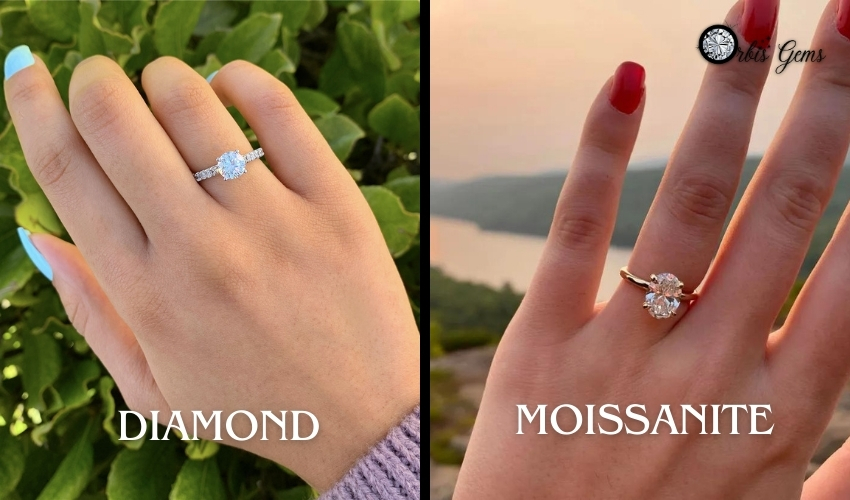
Where to Purchase a Moissanite or Diamond Engagement Ring?
Looking for a stunning moissanite or diamond? Understanding diamond quality is key to ensuring value for money. Diamonds, being both costly and intimate, need careful inspection to appreciate their true sparkle. For the best value, explore online options like James Allen and Blue Nile. Their 360° diamond videos and diverse settings help you find your ideal match.
Moissanite, with its consistent high quality, offers a simpler choice. Explore our online selection, the pioneering creators of gem-grade moissanite. They offer an array of choices to suit every taste.
Can’t find the perfect piece? Unique Engagement Rings is your solution. They specialize in crafting unique pieces, whether you desire a diamond, moissanite, or another gem. Let Unique Engagement Rings guide you to the ideal centerpiece that fits your style and budget, ensuring a piece you’ll treasure.
Moissanite vs Diamond: The Bottom Line
The debate between moissanite and diamonds is a testament to the evolving world of fine jewelry. The choice between moissanite and diamonds depends on personal values, aesthetic preferences, and budget considerations. Both stones have their unique allure and place in the world of luxury, making the decision a personal journey of style, ethics, and taste.
FAQ
What is the main difference between moissanite and diamonds?
Moissanite differs from diamonds primarily in composition and brilliance. While diamonds are made of carbon, moissanite is composed of silicon carbide, giving it a more intense sparkle and slightly different refractive properties.
Are moissanite stones as durable as diamonds?
Yes, moissanite stones are almost as durable as diamonds. Moissanite ranks at 9.25 on the Mohs scale of hardness, just slightly below diamonds, which are the hardest known mineral at a rating of 10.
Is moissanite a good alternative for those seeking ethical and sustainable options?
Absolutely, moissanite is an excellent choice for those prioritizing ethical and sustainable practices. Being lab-created, it avoids the environmental and ethical concerns associated with diamond mining, making it a more eco-friendly and socially responsible option.
References
- Wikipedia: Moissanite
- Brilliant Earth: Moissanite vs. Diamond
- The Diamond Pro: Moissanite vs. Diamond: What are the differences?
- Wikipedia: Diamond
- GIA: OVERVIEW
- Britannica: Diamond
- Abby Sparks: About Abby Sparks Jewelry
- Fire and Brilliance: WHAT IS MOISSANITE?
- Planderful: Fire and brilliance of moissanite
- Teach Jewelry: Diamond Fire vs. Brilliance: Key Differences
- Jewelry Talk: Understanding a Diamond’s Sparkle
- James Allen: Moissanite vs. Diamonds
- Do Amore: Diamonds vs Moissanite
- The Diamond Pro: Moissanite vs. Diamond: What are the differences?
- With Clarity: MOISSANITE VALUE & WORTH
- With Clarity: MOISSANITE CLARITY
- GIA: WHAT IS DIAMOND CLARITY?
- GIA: Diamond Clarity Chart
- Brilliance: Diamond Clarity
- Luxus Moissanite: MOISSANITE HARDNESS
- Wikipedia: Material properties of diamond
- Gem Society: The Mohs Hardness Scale and Chart for Select Gems
- Wikipedia: Material properties of diamond
- Diamond Jewelry Pedia: Hardness of Diamond
- Britannica: Diamond
- Coronet Diamond: THE HARDNESS OF A DIAMOND
- Wikipedia: Material properties of diamond
- Moissanite Co: Physical Attributes: Hardness, Toughness & Durability
- Diamond Rensu: Is Moissanite Harder than a Diamond?
- Wikipedia: Material properties of diamond
- Selecting a Diamond: Diamond vs Moissanite: Pros, Cons, and Key Differences
- Brides: Moissanite Versus Diamonds: What’s the Difference?
- Diamond Mansion: Which Diamond Cut Sparkles the Most?
- Ken and Dana Design: Lab Grown Diamonds vs. Moissanite & Other Natural Diamond Substitutes



